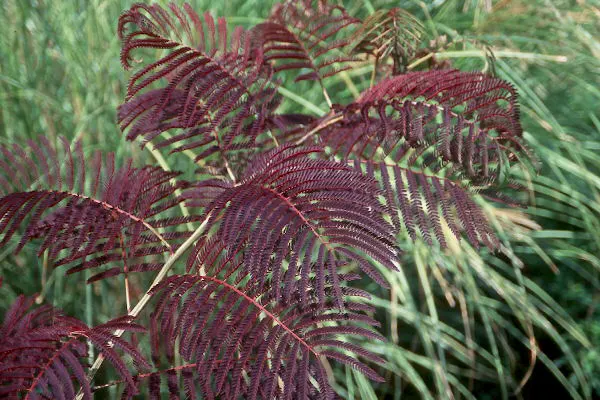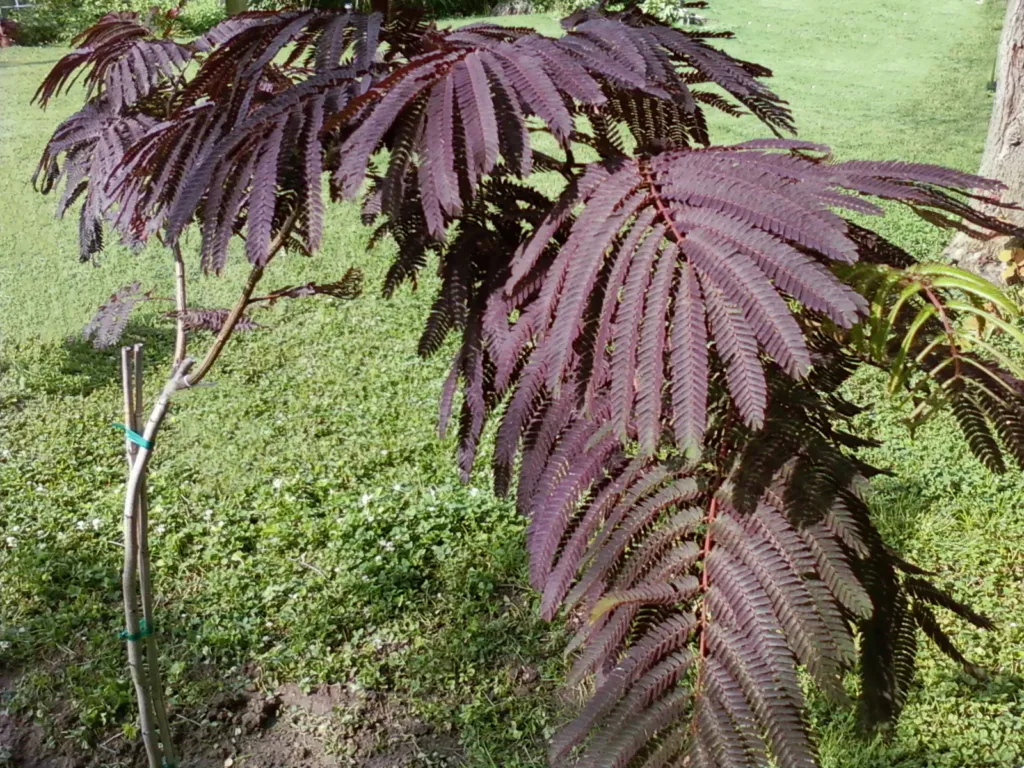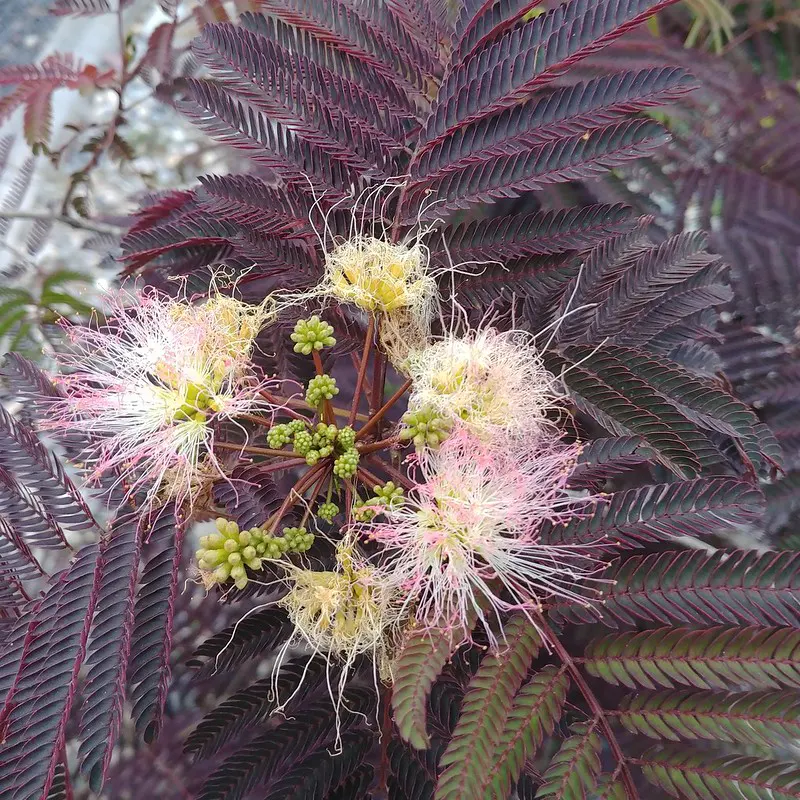Looking to add a dramatic flair to your garden with the Chocolate Mimosa Tree, a flowering tree known for its striking burgundy leaves and pink, pincushion-like flowers? This tree is a garden enthusiast’s dream. It is adaptable, easy to maintain, and a wildlife haven. In this article, we provide you with practical tips on how to plant, grow, and care for your Chocolate Mimosa Tree, ensuring it becomes a resilient and enchanting feature in your outdoor space.
Table of Contents
Crucial Points
- The Chocolate Mimosa Tree has distinct characteristics such as deep purple foliage, an umbrella-shaped canopy, and pincushion-like blooms that attract various wildlife, providing a unique visual and ecological addition to gardens.
- Ideal growing conditions for the Chocolate Mimosa Tree include full sun exposure, well-drained soil, and a subtropical or coastal climate (USDA zones 7-10), with the adaptability to tolerate various soil types and some shade.
- While generally low-maintenance, the tree benefits from proper care practices such as spring fertilization with slow-release fertilizer, occasional pruning to maintain shape and encourage branching, and regular monitoring for pests and diseases.
Characteristics of the Chocolate Mimosa Tree

The Albizia julibrissin Summer Chocolate Mimosa Tree, often simply referred to as the Chocolate Mimosa, is a spectacle to behold. It’s no ordinary tree; its unique features set it apart from the rest, making it a striking addition to any garden. Its alluring deep purple foliage, umbrella-shaped canopy, and pincushion-like blooms make it a visual feast for the eyes and a magnet for a variety of wildlife. Summer chocolate mimosa trees are truly a remarkable sight.
Join us as we examine the captivating characteristics of this deciduous tree, which can grow several feet tall, below.
Deep Purple Foliage
Imagine a tree that undergoes a magical transformation each year. In the early spring, the Chocolate Mimosa Tree’s leaves emerge as a beautiful bronze-green, lending an ethereal quality to your garden. But the real show begins as the growing season progresses. The leaves mature to a rich chocolate-burgundy color, peaking in summer.
The unique deep purple hue of the foliage is a sight to behold, creating a stunning contrast against the usual green in most gardens. This dramatic color transformation not only adds visual interest to your garden but also makes the Chocolate Mimosa Tree a standout star in any landscape.
Umbrella-Shaped Canopy
Adding to the Chocolate Mimosa Tree’s charm is its wide, umbrella-shaped canopy. This unique feature gives the tree a distinctive silhouette, making it an instant focal point in your garden. The broad canopy is not just visually appealing; it also provides a cool, shady retreat for you and your family during the hot summer months.
So, whether you’re planning a summer picnic or just want a quiet place to relax and read a book, the Chocolate Mimosa Tree’s canopy provides the perfect setting, as it is known to promote thicker canopy growth.
Pincushion-Like Blooms
In late summer, when many other trees have finished their blooming season, the Chocolate Mimosa Tree steals the show with its delicate pink flowers. These pincushion-like blooms are a feast for the eyes and a magnet for wildlife. The nectar-rich flowers attract hummingbirds, offering you an opportunity to witness these fascinating creatures up close.
The blooms provide a striking contrast against the tree’s deep purple foliage, adding another layer of beauty to your garden.
Ideal Growing Conditions for Chocolate Mimosa Trees

Now that you are intrigued by the Chocolate Mimosa Tree, we will discuss the perfect conditions for its growth. Despite its exotic appearance, the Chocolate Mimosa Tree isn’t too finicky about its environment. It thrives in full sun, well-drained soil, and is suitable for coastal and subtropical climates (USDA zones 7-10).
The following sub-sections will detail these conditions, which will help you provide the best care for your Chocolate Mimosa Tree.
Full Sun
Just like sunflowers, Chocolate Mimosa Trees follow the sun. These trees require full sunlight exposure to develop properly and achieve optimal growth. Full sun exposure contributes to the tree’s heat and drought tolerance, making it an excellent choice for hot climates.
However, don’t fret if your garden is slightly shaded. The Chocolate Mimosa Tree has a forgiving nature and can tolerate mild shade. But for the best growth and color, ensure that your tree gets a good dose of sunshine, using mimosa tree sparingly in shaded areas!
Well-Drained Soil
While the Chocolate Mimosa Tree loves the sun, it doesn’t like to sit in water. Moist but well-drained soil conditions are crucial for the healthy growth of this tree. Waterlogged soil can impede the development of the tree’s root system, leading to root rot.
But here’s the good news – the Chocolate Mimosa Tree is incredibly adaptable and can grow in various soil conditions. It can tolerate everything from rocky to acidic to alkaline soils, making it a versatile addition to your garden.
Coastal and Subtropical Climates
If you live by the sea or in a subtropical climate, the Chocolate Mimosa Tree could be your new best friend. These trees have a salt tolerance, making them adaptable to coastal climates. However, they do appreciate some protection from strong winds to prevent damage.
In subtropical climates, it’s important to provide some shade for the Chocolate Mimosa Trees during peak afternoon sun to avoid leaf scorch. With the right care, these trees can thrive in a variety of climates, making them a versatile choice for gardeners.
Planting and Establishing Roots
Having covered the ideal growing conditions, we will now elaborate on the planting process. Ensuring a robust and healthy Chocolate Mimosa Tree requires attention to two crucial aspects: preparing the planting site and establishing the roots.
The following subsections will detail these steps.
Preparing the Planting Site
Before you get your hands dirty, it’s essential to prepare the planting site for your Chocolate Mimosa Tree. This tree requires a location with full sun and moist but well-drained soil for optimal growth. Luckily, it’s not too picky about the type of soil. Whether rocky, acidic, or alkaline, the Chocolate Mimosa Tree can adapt to various soil conditions. Just ensure that the soil is well-draining to prevent waterlogging and root rot.
Creating a Peat Moss Soil Mixture
A good soil mix can make a world of difference to your tree’s growth. When backfilling the planting hole, use a mixture of 1 part sphagnum peat moss to 4 parts soil. This mix aids in providing proper drainage and acidifying the soil, creating an ideal environment for the Chocolate Mimosa Tree’s growth.
If you can’t find sphagnum peat moss, no worries – the tree is adaptable and can thrive in various soil conditions.
Watering Practices
Watering is a crucial part of the planting process. Here are some tips for watering the Chocolate Mimosa Tree:
- Water deeply but infrequently
- Ensure the top inch of soil is dry before watering again
- This approach allows the moisture to penetrate deeply and encourages a robust root system.
Once the roots are well established, the tree becomes highly drought-resistant and drought tolerant, reducing the need for frequent watering. Remember, the key to successful watering is moderation – too little or too much can harm your tree.
Caring for Your Chocolate Mimosa Tree
With your Chocolate Mimosa Tree planted, we will now discuss its care. Although the tree is low maintenance, it benefits from some attention. You will find detailed information on spring fertilization, occasional pruning, and monitoring for pests and diseases in the following subsections.
Fertilization
A little food can go a long way in keeping your Chocolate Mimosa Tree healthy. Fertilize the tree in spring with a balanced, slow-release fertilizer to support growth. If the leaves begin to yellow, an application of iron chelates can help, as this could indicate a possible iron deficiency. But remember, moderation is key – while the Chocolate Mimosa Tree appreciates a good meal, over-fertilization can damage the tree.
Pruning
Pruning is an essential aspect of tree care. But don’t worry – with the Chocolate Mimosa Tree, you won’t need to break a sweat. This tree maintains its growth and form without much human intervention.
However, if you want to keep your tree in top shape, prune in late winter. This will help maintain its shape and encourage branching. Just remember to remove any dead or damaged branches and thin out crowded areas to improve air circulation.
Monitoring for Pests and Diseases
Even with the best care, your Chocolate Mimosa Tree may sometimes face threats from pests and diseases. Regularly inspect the leaves for signs of pests like mites or aphids, and treat with appropriate insecticides to avoid infestations.
Diseases like chocolate spot fungus and mimosa wilt can be prevented through proper spacing and air circulation around the tree. If you notice any signs of disease, treat immediately to avoid further damage.
Attracting Wildlife with Your Chocolate Mimosa Tree

Blooming
An added benefit of a Chocolate Mimosa Tree in your garden is its wildlife-attracting ability. The tree’s flowers and canopy attract a diverse range of creatures, from birds to butterflies and bees, adding a dynamic element to your garden.
We will now discuss the various types of wildlife this tree attracts and the ecological benefits it provides.
Birds
The Chocolate Mimosa Tree is a bird magnet, thanks to its vibrant flowers. Various birds, like hummingbirds, are drawn to the tree, adding movement and natural beauty to your garden. So, whether you’re a bird watcher or just enjoy the serene sight of birds fluttering around, the Chocolate Mimosa Tree won’t disappoint.
Other Wildlife
While the Chocolate Mimosa Tree attracts a variety of birds, it also does a great job of keeping deer at bay. The off-putting scent of the tree’s leaves and its dark foliage are less appealing to deer, reducing the potential for animal-related damage to the tree and surrounding plants.
This natural resistance to deer is a bonus for gardeners dealing with wildlife.
Ecological Benefits
The Chocolate Mimosa Tree is not just a visual delight; it’s also an ecological powerhouse. Its deciduous nature provides edible leaves and flowers that serve as important food sources for various species. Plus, its broad, umbrella-shaped canopy acts as shelter for wildlife, enhancing the tree’s ecological benefits.
So, by planting a Chocolate Mimosa Tree, you’re not just embellishing your garden but also contributing to bio-diversification.
Purchasing and Shipping Information
If you’re excited about adding a Chocolate Mimosa Tree to your garden, we’ll discuss where you can buy one and the considerations for shipping.
Whether you prefer online shopping or visiting a local garden center, we’ve got you covered in the following subsections.
Online Purchasing
The convenience of online shopping extends to purchasing trees too! Chocolate Mimosa Trees are available for purchase online. However, do remember to check for shipping restrictions. Some online retailers may not ship to certain areas due to agricultural regulations.
Local Purchasing
If you prefer a more hands-on approach, local garden centers and nurseries may carry the Chocolate Mimosa Tree. Buying locally allows you to see the tree in person before making a purchase. Plus, you can skip the wait for shipping and transport the tree directly to your garden.
Shipping Restrictions and Estimated Times
While purchasing online offers convenience and free shipping, it’s essential to be aware of shipping restrictions and estimated times. Due to regional agricultural regulations, the Chocolate Mimosa Tree cannot be shipped to certain regions such as Alaska, California, and Hawaii. Also, check with the seller for estimated shipping times, as this information can vary.
Customer Reviews and Experiences
Learning from others’ experiences can be insightful. While many customers praise the beauty and low maintenance of the Chocolate Mimosa Tree, some have encountered challenges with germination, diseases, and cold sensitivity.
The following subsections will explore positive reviews, potential challenges, and tips from experienced growers.
Positive Reviews
Customers typically rave about the Chocolate Mimosa Tree for the following reasons:
- Striking appearance with unique chocolate-colored leaves
- Adds visual appeal to gardens
- Rapid growth
- Vibrant contrast against other plants with its unique foliage
The low maintenance nature of the Chocolate Mimosa Tree is another aspect that customers appreciate.
Potential Challenges
Despite the rave reviews, some customers have faced challenges with Chocolate Mimosa Trees. Some reported low germination rates and suggested that selling starts might be preferable. Issues with diseases like mimosa wilt have been a concern for some buyers, highlighting the need for careful monitoring and appropriate preventive measures.
Some growers also mentioned that the tree is sensitive to frost, suggesting challenges in cold climates.
Tips from Experienced Growers
Learning from experienced growers can provide invaluable insights. Here are a few tips from those who have successfully grown Chocolate Mimosa Trees.
First, water the tree deeply but infrequently. Monitor the soil moisture and ensure the top inch of the soil is dry before watering again. Prepare the soil with a mix of organic materials and make sure it is well-draining. Fertilize the tree with a slow release tree fertilizer, but avoid over-fertilization. Regularly inspect the tree for signs of pests and diseases, and treat immediately to avoid infestations.
Summary
In conclusion, the Chocolate Mimosa Tree is a unique and captivating addition to any garden. Its deep purple foliage, umbrella-shaped canopy, and pincushion-like blooms make it a stunning visual delight. Despite its exotic appearance, it’s a low-maintenance tree that thrives in a variety of conditions. And the bonus? It attracts a myriad of wildlife, adding life and movement to your garden. So why wait? Transform your garden into a tropical paradise with a Chocolate Mimosa Tree!
Commonly Asked Queries
What is the Chocolate Mimosa Tree and where does it originate from?
The Chocolate Mimosa Tree, also known as Albizia julibrissin ‘Summer Chocolate’, is a cultivar of the Persian silk tree. It is renowned for its unique chocolate-burgundy colored foliage and pink, fluffy, pincushion-like flowers. This tree is a result of selective breeding to enhance its distinctive color and form. It originates from Asia, specifically from regions stretching from Iran to Japan. Over time, it has been cultivated in various other parts of the world for its ornamental value and ability to adapt to a range of climates.
How much sun does a Chocolate Mimosa Tree need?
The Chocolate Mimosa Tree thrives in full sun but can tolerate mild shade. It’s important to ensure your tree receives a good amount of sunshine for optimal growth and color.
What type of soil is best for a Chocolate Mimosa Tree?
The best type of soil for a Chocolate Mimosa Tree is moist but well-drained, and it can adapt to various soil conditions such as rocky, acidic, and alkaline soils. Choose this type of soil to support healthy growth of the tree.
How often should I water a Chocolate Mimosa Tree?
Water your Chocolate Mimosa tree deeply but infrequently, making sure the top inch of soil is dry before watering again. Once the roots are established, the tree will need less frequent watering and will become drought-resistant.
Can the Chocolate Mimosa Tree be grown in coastal and subtropical climates?
Yes, the Chocolate Mimosa Tree can be grown in coastal and subtropical climates, as it is adaptable to coastal climates and thrives in subtropical regions with some shade during peak afternoon sun to avoid leaf scorch.
What wildlife does the Chocolate Mimosa Tree attract?
The Chocolate Mimosa Tree attracts a variety of birds such as hummingbirds, butterflies, and bees, but it is less appealing to deer due to its scent and dark foliage.

Leave a Comment